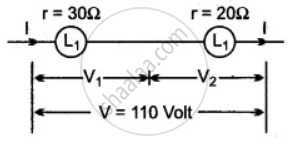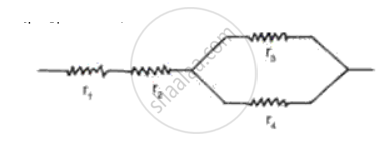Advertisements
Advertisements
प्रश्न
Two lamps of resistance 30Ω and 20Ω respectively are connected in series in a 110V circuit. Calculate:
(i) the total resistance in the circuit
(ii) the current in the circuit, and
(iii) the voltage drop across each lamp.
उत्तर

(i) Since the two lamps are connected in series, their total resistance R is given by:
R = R1 + R2
= 30 Ω + 20 Ω = 50 Ω
(ii) We have, V = 110 volt, R = 50 Ω
∴ By Ohm's law
I = `"V"/"R" = 110/50`A = 2.2 A
(iii) We now have
I = 2.2 A
∴ V1 = IR1 = 2.2 × 30V = 66 V
∴ Voltage frop across L1 = 66 V
Similarly, V2 = IR2 = 2.2 × 20 = 44 V
∴ Voltage drop across L2 = 44 V.
APPEARS IN
संबंधित प्रश्न
What is (a) highest, and (b)Ω lowest, resistance which can be obtained by combining four resistors having the following resistances?
4 Ω, 8 Ω, 12 Ω, 24 Ω
How will you oonnect five resistors, each of the value one ohm, to obtain an equivalent resistance of 0.2 `Omega`
Calculate the equivalent resistance of the following combination of resistor r1, r2, r3, and r4

How does the resistivity of an alloy such as constantace depends on temperature.
State and explain the laws of resistance.
Six resistances are connected together as shown in the figure. Calculate the equivalent resistance between points A and B.

The resistance of the hot filament of the bulb is about 10 times the cold resistance. What will be the resistance of 100 W-220 V lamps, when not in use?
Show how you would connect three resistors, each of resistance 6 Ω, so that the combination has a resistance of 4 Ω.
